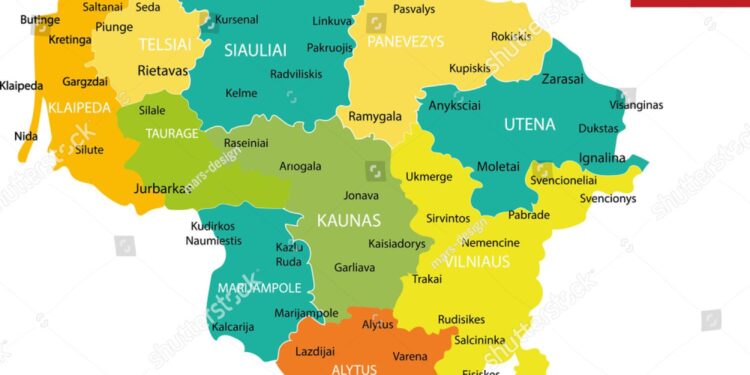Lithuanian authorities have acknowledged challenges in fully safeguarding the country’s airspace against drone incursions, underscoring growing concerns over aerial security in the region. In a recent statement reported by Ukrinform, officials admitted that current defenses are not yet equipped to detect and neutralize all unauthorized unmanned aerial vehicles, highlighting vulnerabilities amid escalating drone activity near Lithuania’s borders. This development raises pressing questions about the readiness of Baltic airspace protection in the face of increasingly sophisticated drone threats.
Lithuania Acknowledges Gaps in Drone Airspace Security Amid Rising Threats
In a recent statement, Lithuanian defense officials have admitted to significant vulnerabilities in the country’s drone airspace security. Despite ongoing efforts to bolster surveillance and interception capabilities, experts underscore that current systems fall short in addressing the evolving sophistication of unmanned aerial threats. The rapid increase in unauthorized drone activities, especially near critical infrastructure, has exposed gaps that could be exploited by hostile actors to undermine national security.
Authorities have highlighted several challenges hindering comprehensive drone defense, including:
- Limited detection range: Existing radar and sensor networks are often inadequate against small, low-flying drones.
- Insufficient countermeasures: The lack of advanced neutralization technologies restricts rapid response capabilities.
- Regulatory complexities: Coordination between civilian and military airspace control remains fragmented.
| Aspect | Current Status | Planned Upgrade |
|---|---|---|
| Detection Range | Up to 2 km | 5 km+ with new sensors |
| Counter-Drone Tech | Minimal | Laser & RF jamming systems |
| Response Time | Several minutes | Real-time interception |
Challenges Faced by Lithuanian Authorities in Countering Unmanned Aerial Surveillance
Lithuanian authorities grapple with numerous obstacles in their efforts to secure national airspace from the growing threat of unmanned aerial vehicles (UAVs). The primary difficulty lies in the sheer volume and variety of drones operating near sensitive areas, making identification and interception a complex task. Many drones are small, commercially available models equipped with advanced features, which complicates detection using traditional radar and surveillance technology. Additionally, the constantly evolving tactics used by drone operators further exacerbate these challenges, forcing security forces to continually adapt their countermeasures.
Budgetary and technical constraints also hinder the comprehensive protection of Lithuanian airspace. Investments in anti-drone technologies require rapid modernization, yet limitations in funding slow down the acquisition of state-of-the-art systems. Furthermore, authorities must navigate a delicate balance between enforcing strict airspace controls and allowing legitimate civilian drone usage for commercial and recreational purposes without infringing on privacy or civil liberties. The table below summarizes key challenges faced by Lithuanian security agencies:
| Challenge | Description |
|---|---|
| Detection Limitations | Small drone size and low radar signature |
| Technological Adaptation | Rapid evolution of drone technologies and tactics |
| Financial Constraints | Limited funding for advanced countermeasures |
| Legal and Civil Concerns | Balancing security with drone operators’ rights |
Experts Urge Enhanced Regional Cooperation and Advanced Technologies to Strengthen Drone Defense
Facing persistent challenges in countering unmanned aerial threats, defense specialists highlight that no single nation can guarantee complete airspace security against advanced drone incursions alone. Lithuania’s recent admissions reflect a broader regional vulnerability that demands not only upgrading national systems but also fostering strong alliances to share intelligence, resources, and rapid response capabilities.
Key strategic measures proposed include:
- Joint investment in cutting-edge drone detection and neutralization technologies
- Standardized protocols for cross-border drone threat assessment and incident reporting
- Integrated training exercises to streamline coordinated defense efforts
Experts emphasize that embracing artificial intelligence and machine learning in existing air defense networks could significantly improve early-warning precision and automated interception. Without this collaborative and technological evolution, nations like Lithuania may continue to face gaps in their drone defense capabilities.
| Technological Solution | Proposed Benefit | Implementation Status |
|---|---|---|
| AI-Powered Radar Systems | Enhanced detection of low-signature drones | Pilot testing |
| Directed-Energy Weapons | Targeted drone neutralization with minimal collateral | Research phase |
| Multinational Command Center | Coordinated regional response | Planning stage |
To Wrap It Up
As Lithuania acknowledges the current limitations in fully safeguarding its airspace against drone incursions, the revelation underscores broader regional security challenges amid evolving aerial threats. The situation highlights the urgent need for enhanced technological capabilities and increased cooperation among Baltic and EU allies to address the growing risks posed by unmanned aerial systems. As Lithuania and its partners work toward strengthening their defense measures, the development serves as a stark reminder of the changing nature of modern warfare and the importance of vigilance in protecting national sovereignty.
















